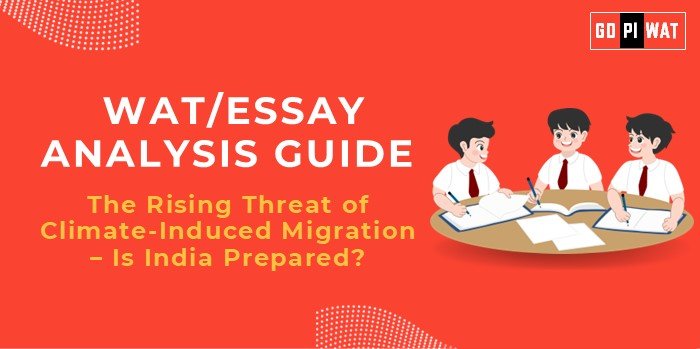📋 Written Ability Test (WAT) Analysis Guide
🌍 Topic: The Rising Threat of Climate-Induced Migration – Is India Prepared?
🌐 Understanding the Topic
🌏 Climate-induced migration is a global phenomenon reshaping demographic and economic landscapes. For India, addressing this challenge requires a delicate balance of urban planning, climate adaptation, and social inclusivity.
📝 Effective Planning and Writing
- ⏳ Time Allocation:
- 🕒 Planning: 5 minutes
- ✍️ Writing: 20 minutes
- 🔍 Review: 5 minutes
- 📋 Preparation Tips:
- 📊 Identify relevant data, such as urban migration rates and coastal population statistics.
- 🌍 Highlight stakeholders and case studies to strengthen arguments.
💡 Introduction Techniques for Essays
- ⚖️ Contrast: “While India’s disaster warning systems have saved lives, the rising tide of climate migration remains unaddressed.”
- 🌱 Solution-Oriented: “Strengthening urban resilience is crucial for India to manage the increasing threat of climate-induced migration.”
🛠️ Structuring the Essay Body
- 🏆 Achievements:
- 🌀 Proactive cyclone warning systems and disaster-resilient housing initiatives.
- ✅ Odisha’s success in minimizing impacts post-Cyclone Fani.
- ⚠️ Challenges with Comparative Analysis:
- 🏙️ Urban infrastructure gaps compared to Bangladesh’s effective resettlement models.
- 💧 Limited flood mitigation strategies when contrasted with the Netherlands.
- 🌟 Future Outlook:
- 🏘️ Decentralizing urban growth to ease pressure on megacities.
- 🌊 Building resilient coastal communities to reduce displacement risks.
📄 Concluding Effectively
- ⚖️ Balanced Approach: “While India has made strides in disaster management, integrating migration planning with urban policies is crucial.”
- 🌍 Global Comparison: “By learning from Bangladesh and the Netherlands, India can create a sustainable roadmap for climate resilience.”
📊 Analyzing Successes and Shortcomings
🎯 Achievements
- 🌍 Proactive Disaster Responses: Efficient evacuation systems and disaster management policies have reduced casualties significantly.
- 🏠 Localized Housing Projects: Initiatives like disaster-resilient homes in cyclone-prone areas.
⚠️ Challenges
- 📉 Urban Overpopulation: Climate migrants strain already congested cities.
- ❗ Lack of Migration-Focused Policies: No comprehensive strategy to integrate climate migrants into urban planning.
🔑 Recommendations for Sustainable Progress
- 🏙️ Develop Migration-Inclusive Urban Plans: Design policies that integrate migrants into urban economies without overburdening resources.
- 🤝 Strengthen International Collaborations: Leverage funding and expertise from global organizations like the UN and World Bank.
- 🌾 Promote Climate-Resilient Agriculture: Reduce rural distress by adapting agricultural practices to changing climates.
📚 Sample Short Essays
- ⚖️ Balanced Perspective: “India faces a formidable challenge in managing climate migration. While disaster responses have improved, sustainable urban policies will determine long-term resilience.”
- 🔍 Solution-Oriented: “Investing in decentralized urban growth and resilient coastal infrastructure is vital for mitigating India’s climate migration crisis.”
- 🌍 Global Comparison: “Adopting Bangladesh’s resettlement strategies and the Netherlands’ flood prevention measures could help India navigate the complex challenge of climate migration.”


